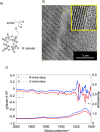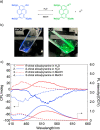Controlling Circularly Polarized Luminescence Using Helically Structured Chiral Silica as a Nanosized Fused Quartz Cell
- PMID: 37885578
- PMCID: PMC10598828
- DOI: 10.1021/jacsau.3c00390
Controlling Circularly Polarized Luminescence Using Helically Structured Chiral Silica as a Nanosized Fused Quartz Cell
Abstract
Circularly polarized luminescence (CPL) is typically achieved with a chiral luminophore. However, using a helical nanosized fused quartz cell consisting of chiral silica, we could control the wavelength and helical sense of the CPL of an achiral luminophore. Chiral silica with a helical nanostructure was prepared by calcining a mixture of polyhedral oligomeric silsesquioxane (POSS)-functionalized isotactic poly(methacrylate) (it-PMAPOSS) and a small amount of chiral dopant. The chiral silica encapsulated functional molecules, including luminophores, along the helical nanocavity, leading to induced circular dichroism (ICD) and induced circularly polarized luminescence (iCPL). Because chiral silica can act as a helical nanosized fused quartz cell, it can encapsulate not only the luminophore but also solvent molecules. By changing the solvent in the luminophore-containing nanosized fused quartz cell, the wavelength of the CPL was controlled. This method provides an effective strategy for designing novel CPL-active materials.
© 2023 The Authors. Published by American Chemical Society.
Conflict of interest statement
The authors declare no competing financial interest.
Figures




References
-
- Jung J. H.; Ono Y.; Hanabusa K.; Shinkai S. Creation of Both Right-Handed and Left-Handed Silica Structures by Sol-Gel Transcription of Organogel Fibers Comprised of Chiral Diaminocyclohexane Derivatives. J. Am. Chem. Soc. 2000, 122 (20), 5008–5009. 10.1021/ja000449s. - DOI
LinkOut - more resources
Full Text Sources
